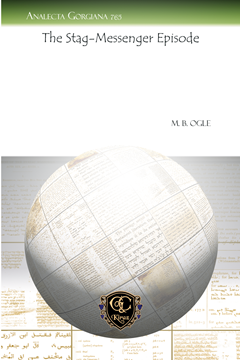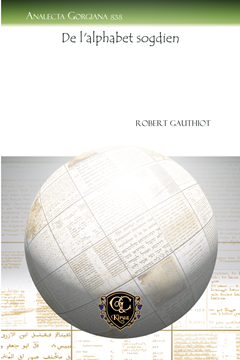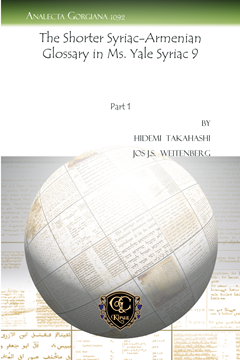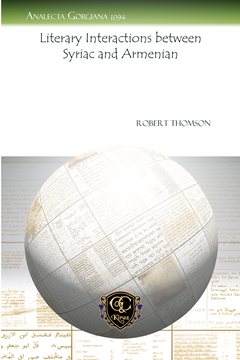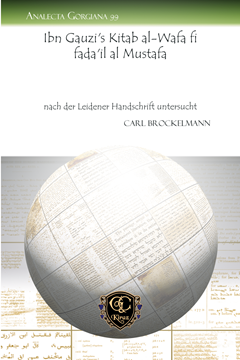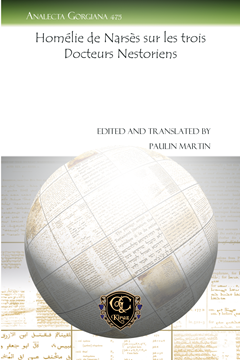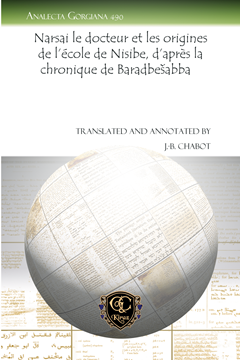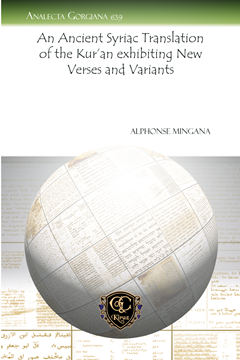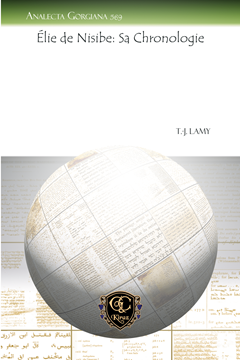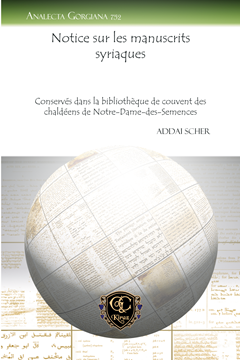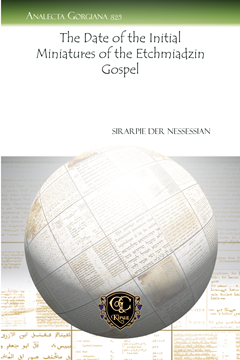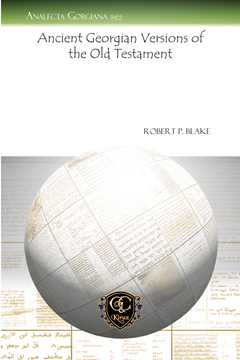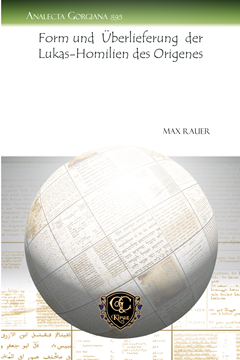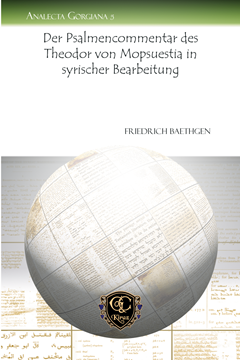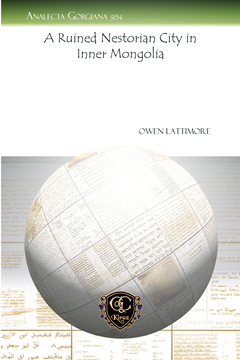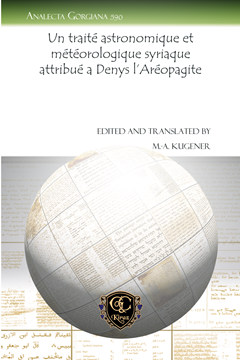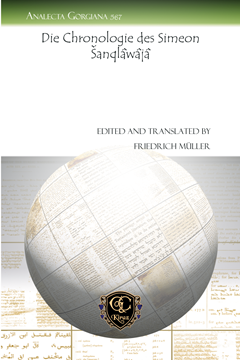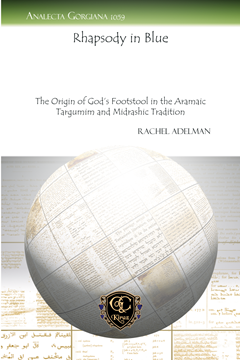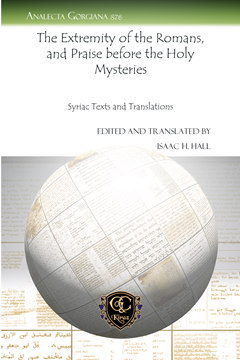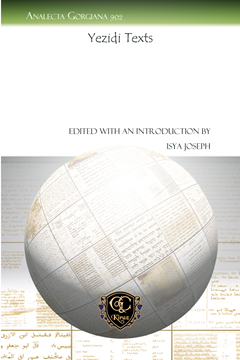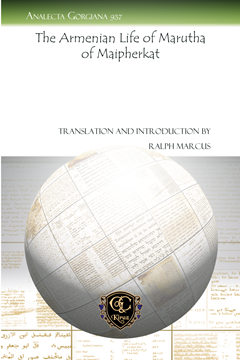Analecta Gorgiana
Analecta Gorgiana is a collection of long essays and short monographs which are consistently cited by modern scholars but previously difficult to find because of their original appearance in obscure publications. Carefully selected by a team of scholars based on their relevance to modern scholarship, these essays can now be fully utilized by scholars and proudly owned by libraries.
The Stag-Messenger Episode
By M. B. Ogle
Series: Analecta Gorgiana 765
ISBN: 978-1-61143-143-8
This article by M.B. Ogle is a demonstration of how the theory that the stag-messenger episode of Medieval literature is Celtic in origin has erred, and proposes it was of oriental provenance.
$37.00 (USD) $22.20 (USD)
De l’alphabet sogdien
Series: Analecta Gorgiana 838
ISBN: 978-1-61143-309-8
This paper, reprinted from the Journal Asiatique, provides a handy introduction to the Sogdian alphabet used for Buddhist texts in Central Asia.
$35.00 (USD) $21.00 (USD)
The Shorter Syriac-Armenian Glossary in Ms. Yale Syriac 9
Part 1
Series: Analecta Gorgiana 1092
ISBN: 978-1-4632-0140-1
Takahashi and Weitenberg provide the history and linguistic analysis of Ms. Yale Syriac 9. Only three such Syriac-Armenian lexica are known to survive. The glossary is classified as the Western branch of Modern Armenian, attributed to Dialect Group 5.
$34.00 (USD) $20.40 (USD)
Literary Interactions between Syriac and Armenian
Series: Analecta Gorgiana 1094
ISBN: 978-1-4632-0142-5
Thomson surveyed Syriac literary influence on Armenian Christianity from the time of early missionary activity to the middle ages. Evidence suggests that Armenian Christians are greatly indebted to Syriac contributions on sainthood and theology, but less so for historical writing.
$34.00 (USD) $20.40 (USD)
Ibn Gauzi’s Kitab al-Wafa fi fada’il al Mustafa
nach der Leidener Handschrift untersucht
Series: Analecta Gorgiana 99
ISBN: 978-1-60724-023-5
This investigation of Abu-al-Faraj Ibn al-Jawzi’s al-Wafa bi Fada'il al-Mustafa, according to the Leiden manuscript by one of Germany’s foremost Semiticists, is essential reading for anyone interested in Arabic history and literature. Ibn al-Jawzi was a twelfth-century jurist and perhaps the most prolific writer in the history of Arabic literature. Al-Wafa bi Fada'il al-Mustafa (Detailed Accounts of the Chosen Prophet), is a large work on the biography of the prophet Muhammad. In this manuscript study, Brockelmann analyzes several aspects of this composition, including citations of this work by other notable Islamic writers.
$45.00 (USD) $27.00 (USD)
Homélie de Narsès sur les trois Docteurs Nestoriens
Edited and Translated by Paulin Martin
Series: Analecta Gorgiana 475
ISBN: 978-1-60724-931-3
In this work, Martin offers the Syriac text, with an annotated French translation, of Narsai’s poem on the three doctors of the Church of the East: Diodore of Tarsus, Theodore of Mopsuestia, and Nestorius.
$57.00 (USD) $34.20 (USD)
Narsai le docteur et les origines de l'école de Nisibe, d'après la chronique de Barḥadbešabba
Translated and Annotated by J.-B. Chabot
Series: Analecta Gorgiana 490
ISBN: 978-1-60724-968-9
This volume contains Chabot’s notice of a fragment published by Mingana from Barhadbeshabba dealing with Narsai and the School of Nisibis. Chabot offers a French translation of the text and a summary questioning its historical value.
$36.00 (USD) $21.60 (USD)
An Ancient Syriac Translation of the Kur’an exhibiting New Verses and Variants
Series: Analecta Gorgiana 639
ISBN: 978-1-61719-588-4
The focus of this study is the final part of Dionysius bar Salibi’s polemical work against the Muslims, which contains a number of quotations from the Qur’an in Syriac translation.
$46.00 (USD) $27.60 (USD)
Untersuchungen zur Syntax des Afraates
I. Die Relativpartikel und der Relativsatz
Series: Analecta Gorgiana 646
ISBN: 978-1-61719-595-2
This grammatical study focuses on how the relative particle is used in the Demonstrations of fourth century Syriac author Aphrahat. A great number of examples from Aphrahat’s writings are included in both Syriac and in German translation.
$43.00 (USD) $25.80 (USD)
Sa Chronologie
By T.-J. Lamy
Series: Analecta Gorgiana 569
ISBN: 978-1-61719-528-0
In this essay, Lamy discusses the Chronography of east Syriac author Elias of Nisibis (975-1046). Numerous extracts in Syriac and in French translation are included.
$40.00 (USD) $24.00 (USD)
Notice sur les manuscrits syriaques
Conservés dans la bibliothèque de couvent des chaldéens de Notre-Dame-des-Semences
By Addai Scher
Series: Analecta Gorgiana 752
ISBN: 978-1-61143-085-1
This catalogue lists 153 manuscripts from the Chaldean monastery Notre-Dame-des Semences, located near Alqosh, Iraq.
$45.00 (USD) $27.00 (USD)
The Date of the Initial Miniatures of the Etchmiadzin Gospel
Series: Analecta Gorgiana 825
ISBN: 978-1-61143-263-3
A controversial essay on one of the treasures of Armenian art, arguing that its illuminations were original and Armenian; with 38 plates.
$38.00 (USD) $22.80 (USD)
Ancient Georgian Versions of the Old Testament
Series: Analecta Gorgiana 862
ISBN: 978-1-61143-411-8
This work is a description and analysis of a unique Old Testament codex in Georgian containing the first eight books of the Bible, the Prophets, and marginal commentary on both.
$37.00 (USD) $22.20 (USD)
Form und Überlieferung der Lukas-Homilien des Origenes
By Max Rauer
Series: Analecta Gorgiana 895
ISBN: 978-1-61143-485-9
This text discusses the writings of Origen on the Gospel according to Luke.
$46.00 (USD) $27.60 (USD)
Der Psalmencommentar des Theodor von Mopsuestia in syrischer Bearbeitung
Series: Analecta Gorgiana 5
ISBN: 978-1-61143-792-8
Baethgen describes a Syriac text purporting to be a translation of a commentary on the psalms by Theodore of Mopsuestia, showing that it cannot be a simple translation of Theodore's commentary but does contain much material derived from him.
$42.00 (USD) $25.20 (USD)
A Ruined Nestorian City in Inner Mongolia
Series: Analecta Gorgiana 954
ISBN: 978-1-61143-871-0
Owen Lattimore, a historian of Central Asia, presents the first report on Kwei-hua, the ruined city of the Syriac-Ongut Turks.
$35.00 (USD) $21.00 (USD)
Shamanism in Siberia and European Russia
By V. M. Mikhailovskii; Translated by Oliver Wardrop
Series: Analecta Gorgiana 972
ISBN: 978-1-61143-905-2
This work presents a detailed first-hand account of shamanic songs, rituals, and healing and initiatory ceremonies from all over Siberia, arranged by tribe.
$39.00 (USD) $23.40 (USD)
Un traité astronomique et météorologique syriaque attribué a Denys l'Aréopagite
Edited and Translated by M.-A. Kugener
Series: Analecta Gorgiana 590
ISBN: 978-1-61719-549-5
Kugener here gives an edition of the Syriac text, along with a thoroughly annotated French translation, of this unique astronomical and meteorological treatise attributed to Dionysius the Areopagite and later used in the 13th cent. by Jacob bar Shakko.
$47.00 (USD) $28.20 (USD)
Die Chronologie des Simeon Šanqlâwâjâ
Edited and Translated by Friedrich Müller
Series: Analecta Gorgiana 567
ISBN: 978-1-61719-615-7
This volume contains long excerpts of the 12th/13th cent. Church of the East author Shem‘on Shanqlawaya’s Chronicon, here given in Syriac and in German translation.
$47.00 (USD) $28.20 (USD)
Rhapsody in Blue
The Origin of God's Footstool in the Aramaic Targumim and Midrashic Tradition
Series: Analecta Gorgiana 1059
ISBN: 978-1-4632-0106-7
Three interpretative trends address the vision at the ratification of the Sinai covenant in Exod. 24:10. Traditions relate whether God or a throne was seen, as well as the consequences for this vision for the leaders and history of the Israelites.
$35.00 (USD) $21.00 (USD)
Das Nestorianische Denkmal in Singan Fu
By J.E. Heller
Series: Analecta Gorgiana 634
ISBN: 978-1-61719-583-9
This work is a survey of the text and research on the famous so-called Nestorian monument (or stele) from China, including a review of previous scholarship, as well a fresh translation and commentary.
$45.00 (USD) $27.00 (USD)
The Extremity of the Romans, and Praise before the Holy Mysteries
Syriac Texts and Translations
Edited and Translated by Isaac H. Hall
Series: Analecta Gorgiana 876
ISBN: 978-1-61143-442-2
These are two unique Syriac texts from the same manuscript.
$36.00 (USD) $21.60 (USD)
Yezidi Texts
Edited with an Introduction by Isya Joseph
Series: Analecta Gorgiana 902
ISBN: 978-1-61143-496-5
This paper provides an Arabic text and English introduction on the holy works and literature of the Yezidi faith.
$41.00 (USD) $24.60 (USD)
The Armenian Life of Marutha of Maipherkat
Translation and Introduction by Ralph Marcus
Series: Analecta Gorgiana 937
ISBN: 978-1-61143-831-4
This work retells the life of the Bishop Marutha of Maipherkat, or Martyropolis, as translated from the Armenian text.
$36.00 (USD) $21.60 (USD)
Exegetische Studien zum Septuagintapsalter
Series: Analecta Gorgiana 32
ISBN: 978-1-4632-0030-5
A series of exegetical studies on the Septuagint psalter, focusing particularly on the extent to which the religious ideas and practice of the translators have influenced the translation and distinguished it from the Hebrew original.
$53.00 (USD) $31.80 (USD)

